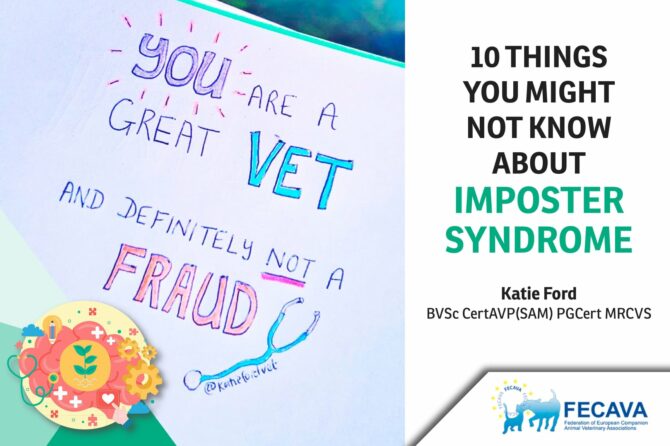
10 Things you might not know about Imposter Syndrome
Imposter syndrome is the label given to a pattern of thoughts, in which an individual doubts their accomplishments and questions their abilities. It can result in signs such as struggling to accept compliments, discounting successes, feeling to be ‘winging it’ when completing tasks, and thinking that others consider them to be more intelligent than they are.
This phenomenon is common in the veterinary profession, and is now becoming more of a topic of conversation. Further information will be linked at the bottom of this article.
Here are ten things that you might not know about imposter syndrome:
1. It is widely cited that up to 70% of the general population have experienced impostor syndrome, with other studies ranging between 9% and 82% depending on screening criteria (Bravata et al., 2019)
2. It was first documented in 1978 by Dr. Pauline Clance and Dr. Suzanne Imes, and whilst initially was thought to be more prevalent in women, it is now considered to equally affect all genders (Bravata et al., 2019)
3. It can be experienced at all levels in the veterinary profession. From student vets and nurse, to diploma and PhD holders – anyone feeling this way is not alone.
4. It is not a mental health disorder, but a set of thoughts in response to stimuli (such as achievement or accomplishments). In some cases, it can progress to depression and anxiety, so if individuals are experiencing this continuously and it is impacting on daily life, seeking the advice of a trained professional is infinitely helpful.
5. Some of those clinicians experiencing imposter syndrome will show minimal external signs, and whilst they might feel under-confident in their abilities and achievements, the external picture may be significantly different.
6. It is believed that the roots of imposter syndrome sit in childhood. Clance and Imes (1978) theorised that individuals with high achieving siblings of which they were constantly compared to, or those with images of perfection from their family were more commonly affected. Now it is understood that there are multiple limiting belief systems that may form the foundations of these thoughts, with many contributing factors. The good news is that these imposter thoughts are based on very little evidence and can be overcome with the correct help and strategies, we simply don’t have to believe them.
7. It is not just a veterinary phenomenon, and has been documented in many fields. Even global celebrities talk of feeling fraudulent.
8. Clance (1985) wrote of how imposter syndrome is driven by a fear of failure, which leads individuals to experience either procrastination or overwork in preparation for a task. A useful strategy in overcoming imposter syndrome is to unmask this fear and realise that failure is a normal and potentially beneficial part of growth.
9. Often imposter syndrome will appear for individuals during times of growth and pushing comfort zones – for example, post-graduation, whilst pursuing further qualifications, in new job roles, following the release of new information or challenging cases. It can be beneficial for individuals to remind themselves that feeling this way can be normal, they are not fraudulent and that this feeling might be highlighting a period of growth.
10. There are a number of further strategies that can help, and it does not have to be ‘just part of the job’ to experience imposter syndrome. Some individuals will find techniques to work on at home useful, whilst others may benefit from external support. The use of mentors and coaches, depending on the circumstance, can be helpful as they can guide from experience (mentors) or help to support and form new belief systems (coaches). Imposter syndrome can be draining, and if it is impacting on other areas of life, or causing mental health concerns, speaking with a medical professional and considering therapy can be very beneficial. Don’t struggle alone.
Katie is passionate about imposter syndrome and spreading the word within the veterinary profession, and offers further information on her website www.katiefordvet.com and social media feeds.
Leave a replyReferences:
Clance, P. and Imes, S., (1978). The impostor phenomenon in high achieving women: Dynamics and therapeutic intervention. Psychotherapy: Theory, Research & Practice, 15(3), pp.241-247.
Clance P (1985) The impostor phenomenon: overcoming the fear that haunts your success.
Peachtree, Atlanta. Bravata, D., Watts, S., Keefer, A., Madhusudhan, D., Taylor, K., Clark, D., Nelson, R., Cokley, K. and Hagg, H., (2019). Prevalence, Predictors, and Treatment of Impostor Syndrome: a Systematic Review. Journal of General Internal Medicine, 35(4), pp.1252-1275.

Leave a reply